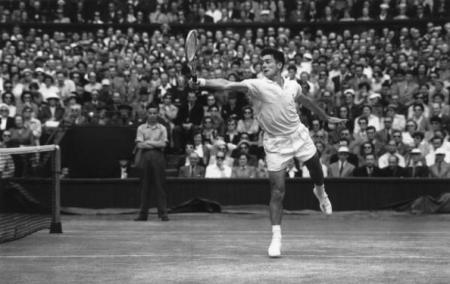Don Budge (center) with the 1937 U.S. Davis Cup team
Don Budge’s name will be familiar to many readers as the winner of the first official “Grand Slam” in tennis history, having swept the major Australian, French, Wimbledon, and U.S. Championships in 1938. This, however, only scratches the surface of Budge’s incredible career. He won an all-time record six straight majors as an amateur between 1937 and 1938, achieving a 92-match winning streak along the way. (According to Bud Collins the only longer unbeaten run was by Bill Tilden in the mid-1920s, though Tilden was competing only in America and against less robust opposition.) Budge also won what many observers still consider the greatest match of all time against Baron Gottfried Von Cramm in the 1937 Davis Cup semifinal.
It can be argued, of course, that two of the best players in the world, Ellsworth Vines and Fred Perry, were not in amateur competition during Budge’s great two-year amateur run, as they were engaged in the early professional tours. Budge, however, turned pro himself in 1939 and defeated both Vines and Perry in series of matches, leaving no doubts as to who was the greatest player of their time. Budge’s peak years were sadly cut short by World War II. Budge sustained a shoulder injury while in service that would hamper him for the rest of his career. Nevertheless, after the war Budge continued to compete at the highest level, losing narrowly to Bobby Riggs in their 1946 tour. An aging Budge also reached the finals of the U.S. Pro Championships in 1949 and 1953, losing first to Riggs, then to Pancho Gonzales, who would dominate pro tennis for nearly a decade.
Budge’s predecessors and successors alike have stood in awe of his unbreakable all-court game. Tilden called him “the finest player 365 days a year that ever lived.” Jack Kramer, the foremost player of the late 1940s and early 1950s, often stated that Budge was the best player of all time (followed in his opinion by Vines and Tilden) until he revised his judgment two years ago in favor of Roger Federer. Budge’s backhand has been universally admired; it is often regarded as the single greatest shot in the history of tennis. Julius Heldman, in his piece “Styles of the Greats” (1971), argued that Budge’s forehand was nearly as good. The great sportswriter Will Grimsley wrote in 1971 that Budge was “considered by many to be foremost among the all-time greats.” E. Digby Baltzell echoed this sentiment in his book Sporting Gentlemen (1994), where he wrote that Budge and Rod Laver, the only two male players to have won the official Grand Slam, “have usually been rated at the top of any all-time World Champions list, Budge having a slight edge.” Polls and experts have routinely listed Budge among the top five or six players in the history of tennis, even though knowledge about him has recently declined.
For me, Budge remains among the top four players who ever lived. Along with Tilden, Ken Rosewall, and Laver, he is one of tennis’s greatest all-court, all-surface champions, and like them he was nearly as good a doubles player as he was in singles. In fact, to this day Budge holds one of the most impressive records in tennis history, having won the so-called “Wimbledon Slam” (consisting of the singles, doubles, and mixed doubles titles) in back-to-back years. He had every shot, and no part of his game could be considered a weakness. Budge could pound the ball hard like Vines, and he could take the ball on the rise like Henri Cochet or Perry. Even though he did not have the fast cannonball service of Tilden, Vines, or Gonzales, Budge’s serve was considered one of the heaviest in his day. Though Budge was most comfortable playing from the baseline, he was also adept at net, and he even had an excellent stroke volley–a shot which many of today’s fans wrongly believe was a recent invention!
Don Budge is the only tennis player in history to be named Athlete of the Year by the Associated Press twice (1937 and 1938). He was dominant both as an amateur and as a pro. That he conquered such first-class rivals during his years at the top–Tilden, Vines, Perry, Von Cramm, and Riggs (prior to World War II), among others–solidifies his claim to tennis greatness, and his heroic comeback victory in the epic 1937 Davis Cup match against Von Cramm lifts his name into the realm of sporting legend. (I recommend reading Budge’s A Tennis Memoir, especially the first chapter where Budge retells the story of this classic match in some detail. See also this link for an audio recording of Budge’s post-match comments from 1937, and follow this link for a short video clip of the famous Budge backhand.)



